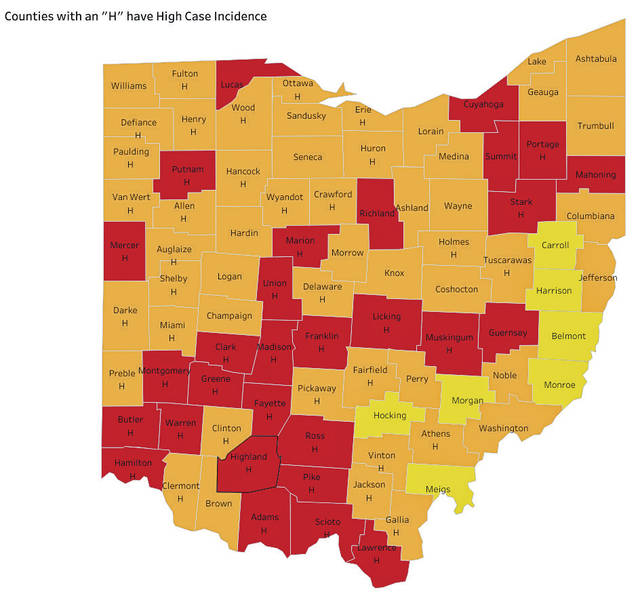

Four additional Highland County residents died due to COVID-19 as of Friday, Highland County Health Commissioner Jared Warner reported. Ohio Gov. Mike DeWine also addressed Highland County residents during his Friday press conference.
Warner did not release any additional information regarding the recent deaths.
On Thursday, Highland County became one of Ohio’s 29 “red” counties — counties that, based on seven alert indicators the Ohio Public Health Advisory System (OPHAS) uses to determine risk levels, are experiencing “very high” exposure and spread of COVID-19. OPHAS also indicated that Highland County has a high case incidence.
Nearby counties — Adams, Fayette, Pike, Ross and Scioto — were also “red” counties with high case incidences as of Thursday.
OPHAS considers “red” counties to be in level 3 public emergencies.
Due to the high risk of exposure, the Ohio Department of Health (ODH) advises level 3 counties to “Limit activities as much as possible. Follow all current health orders.”
In a Thursday Facebook post, Jared Warner explained that increased OPHAS alert levels do not trigger any immediate local action.
“An increase in our alert levels does not trigger any immediate actions or change local policy for COVID-19,” Warner wrote. “No school district plans are tied into state alert levels.
“It is also important to remember that the cases and trends we are seeing now are not real time. We are looking into the past at where we were in the past week or so. It takes time for someone to become symptomatic, time for someone to feel sick enough to get tested, and time for the tests to be analyzed and returned.
“What it really means is that we are trending in the wrong direction with COVID-19 cases in Highland County. It means we need to be careful, and that we need to renew our efforts to reduce disease transmission.”
As of Thursday, Highland County met four of OPHAS’s seven alert indicators: Indicator 1, which measures the number of new cases per capita over the last two weeks; Indicator 2, which measures an increasing trend of new cases; Indicator 3, which measures the proportion of cases in a congregate setting — such as nursing homes — to cases in a non-congregate setting — such as within the general community; and Indicator 5, which measures an increasing trend in the number of people who go to a health care provider with symptoms of COVID-19 and receive a confirmed or suspected COVID-19 diagnosis.
In a Friday post, Warner also stated that the health department is carefully monitoring the Southwestern Ohio region’s hospital capacity due to COVID-19’s hospitalization rate.
“Our current hospital capacity is something that is directly influenced by our COVID-19 case rates,” Warner wrote. “In Ohio, approximately 9.6 percent of identified cases have required hospitalization. We can estimate that roughly 1 out of 10 newly identified cases in Highland County will end up in the hospital somewhere in SW Ohio. This morning we are sitting at 90 percent full for our adult medical-surgical beds in the region. This doesn’t leave a large cushion for an increase in hospitalization if we continue this trend of increasing cases. The health care system has the ability to make additional bed capacity, but it isn’t something that they like to do both from an economic or quality of care standpoint. This is one of the data points that we watch especially closely during COVID-19 increases.”
According to DeWine, 70 out of Ohio’s 88 counties were “red” and/or had high case incidences as of Thursday.
“That’s 10 million Ohioans or 85 percent of the population, living in an area with a high risk of community transmission,” DeWine said Thursday.
Warner urged community members to follow state COVID-19 guidelines.
“It has never been a question of whether we will get through this pandemic. It has always been a question of how high the cost will be,” Warner wrote. “Stay home if you feel sick, wash your hands, keep your distance from others, avoid large gatherings where possible, and wear a mask. If you care about the health of this community, please show it with your actions.”
Earlier Thursday, Warner announced that the Highland County Health Department would be closed to the public for the day beginning at 1 p.m.
“We have some additional long term care and school cases that have come in and I am moving staff over to help the nurses,” Warner wrote.
The health department also closed for similar reasons on Oct. 9, and health department nurses worked through the Columbus Day holiday, while the office was also closed to the public.
During DeWine’s Friday press conference in Cincinnati, DeWine urged Highland County residents who reject masks and COVID-19 precautions in general to participate in safe Covid practices.
“Highland County, which has a population of 43,000, had 101 new cases in the last two weeks. That puts them at a rate per 100,000 of 234 [new cases per capita] — over two and a third times what the high incidence rate is. [Highland County currently has] eight hospitalizations. Again, hospitalizations are a lagging indicator,” DeWine said. “In the spring, if you lived in a rural county, you felt pretty safe — not in the fall. It’s everywhere now. There’s no place you’re safe. Living in Highland County may protect you from some things, but it does not protect you against the COVID virus.”
DeWine also stated during the press conference that Friday was the third consecutive day that Ohio had over 2,000 new COVID-19 cases per day.
“Three months ago, we were really starting to see cases go up again, and Ohioans put on masks. We saw a high rate of compliance in Hamilton County. As a direct result of that, we saw cases go down,” DeWine said, “so we know what works — absolutely no doubt what works: keeping your distance, wearing a mask. We can go about our business; we can enjoy life, but wear a mask. It’s a very critical time where we have to step up.”
The following are the COVID-19 numbers for Highland County as of Friday:
The Highland County Health Department has recorded a total of 395 lab-confirmed and probable COVID-19 cases.
The health department also reported that 95 people were actively sick and six were hospitalized in connection with COVID-19. The health department was also monitoring 343 people for symptoms.
There have been a total of 36 COVID-19-related hospitalizations and eight COVID-19-related deaths in Highland County, and 292 patients have recovered from COVID-19.
The Highland County Health Department did not provide updated COVID-19 numbers for the county’s nursing homes on Friday.
The following are the number of COVID-19 cases in local nursing homes as of Wednesday, according to the health department:
* Crestwood Ridge Skilled Nursing and Rehabilitation in Hillsboro had 38 cases involving residents and 12 involving staff.
* The Laurels of Hillsboro had 23 cases involving residents and nine involving staff.
* Heartland of Hillsboro had one case involving a resident and two involving staff.
For more information on the COVID-19 pandemic in Ohio, visit coronavirus.ohio.gov.
Reach McKenzie Caldwell at 937-402-2570.



